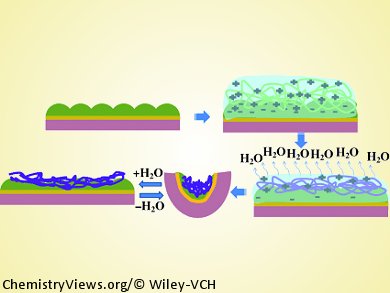Hard Working Polymer
A small plastic strip can do “weight training” to effortlessly lift many times its own weight, driven by cyclic changes in the humidity of the surrounding air. This strong “artificial arm” is based on the interaction between microgels and a layer of polycations that shrinks as it dries, according to a report presented by Canadian researchers in the journal Angewandte Chemie.
Polymer materials that perform work in response to a chemical or physical stimulus are often called “artificial muscles”. These are very interesting for a number of applications, including controlling the movements of “gentler” robots. All components of such robots need to be soft and flexible so that they don’t damage delicate objects and can move in tight spaces.
Microgel Monolayer
The arm developed by researchers working with Michael J. Serpe at the University of Alberta is constructed in the following way: A strip of a plastic film is coated with chromium and gold, followed by a microgel monolayer. Microgels are cross-linked polymers that swell up with a solvent such as water to form gel particles with diameters of up to a few micrometers. The Canadian researchers used negatively charged microgels made from poly(N-isopropylacrylamide) and acrylic acid. A solution containing polycations is deposited onto the gel. These act as positive counterions.
When this system dries out, the hydrophobic interactions between the hydrocarbon regions of the polymer cations increase considerably, which causes the layer containing the polymer cations to shrink. Because the electrostatic attraction between the polycations and the microgel is very strong and the microgel layer is very firmly attached to the coated sheet of plastic, the ends of the strip bend upwards and the system curls up. When the air humidity is increased, it stretches back out.
Testing the Artificial Arm
The researchers hung one of their strips up in a chamber with controlled humidity conditions. By changing the humidity, they were able to make their artificial arm “grip” the handle of a small package and to “hold on” as it rose up. In another experiment, they hung a chain of paperclips to the end of one extended mini-arm. Cyclic changes in the humidity caused the arm to raise and lower this weight, which was 14 times as heavy as the arm itself, like a miniature weight-lifting exercise. “Given that a human arm is approximately 6.5 % of the total mass of the human body, this is equivalent to a 75 kg human with a single arm that is capable of lifting 68.3 kg,” Serpe says to illustrate the strength of his miniature arm. Even hanging 52.2 g of weight from a curled-up arm was not enough to stretch it out. If a 75 kg human wanted to achieve a similar feat, he would have to keep his arm bent even with 1280 kg pulling on it.
- Polymer-Based Muscle Expansion and Contraction,
Molla R. Islam, Xue Li, Keady Smyth, Michael J. Serpe,
Angew. Chem. Int. Ed. 2013.
DOI: 10.1002/anie.201303475




